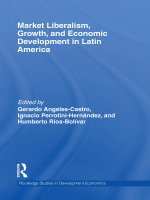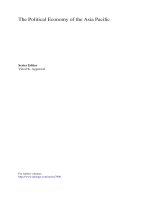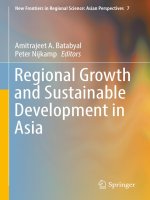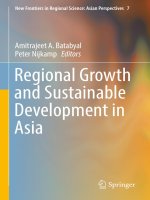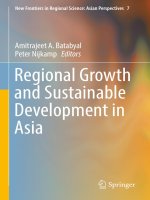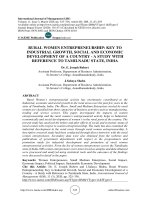Economic growth and economic development 38
Bạn đang xem bản rút gọn của tài liệu. Xem và tải ngay bản đầy đủ của tài liệu tại đây (43.82 KB, 1 trang )
.06
Introduction to Modern Economic Growth
KOR
average growth gdp per capita 1960-2000
-.02
0
.02
.04
HKG
BRB
COG
ZWE
IRL
PRT
MYS
MUS
ROM
CPV
LUX ESP
IDN
GRC
NOR
AUT
FIN
ITA
ISR
PAK
DOM
ISLIND
BRA BEL
SYR
FRA
EGY
GAB
MAR
USA
NLD CAN
TTOCHL
PAN
TUR
LKA
DNK
AUS
SWE
IRNGBR
MEX
COL
PRY
MWIDZA
CHE
ECU
PHL
JOR
CRI
GTM
URY
NZL
GHAGNB
KEN
BGD
ZAF
PER ARG
JAM
SLV
TZA
ETH
CMR
HND
CIVBOL
BEN
GIN
BDI
MLI RWA TGO
SEN
VEN
COM
TCD
ZMB
MDG
MOZ
NIC
NER
-.05
THA
CHN
JPN
SYC
LSO
NPL
UGA
GMB
BFA
GNQ
NGA
0
.05
average growth investment 1960-2000
.1
.15
Figure 1.16. The relationship between average growth of GDP per
capita and average growth of investments to GDP ratio, 1960-2000.
For this reason, we start with the more modest question of what factors correlate
with post-war economic growth. With an eye to the theories that will come in the
next two chapters, the two obvious candidates to look at are investments in physical
capital and in human capital.
Figure 1.16 shows a strong positive association between the average growth of
investment to GDP ratio and economic growth. Figure 1.17 shows a positive correlation between average years of schooling and economic growth. These figures
therefore suggest that the countries that have grown faster are typically those that
have invested more in physical capital and those that started out the postwar era
with greater human capital. It has to be stressed that these figures do not imply
that physical or human capital investment are the causes of economic growth (even
though we expect from basic economic theory that they should contribute to increasing output). So far these are simply correlations, and they are likely driven, at
24
